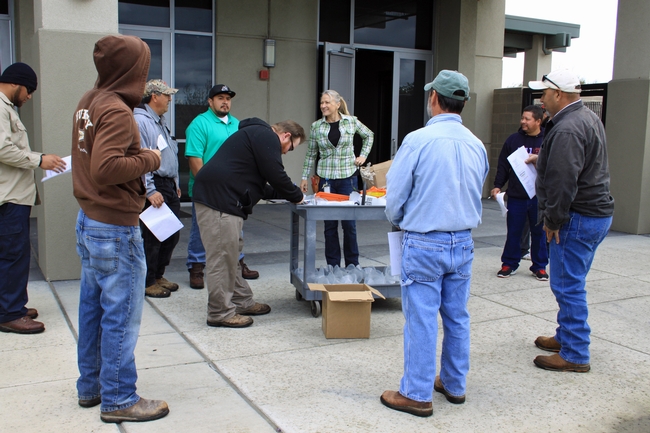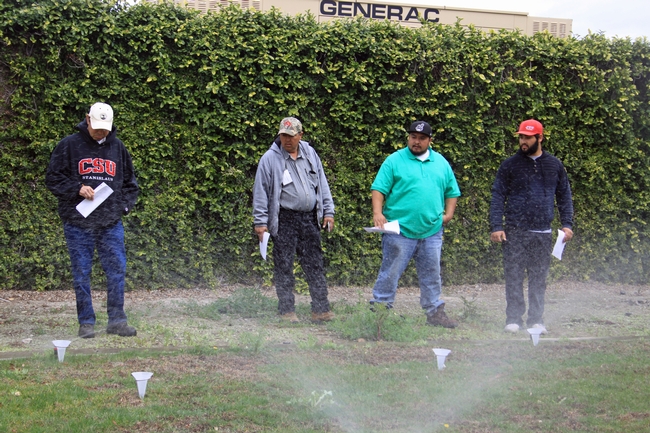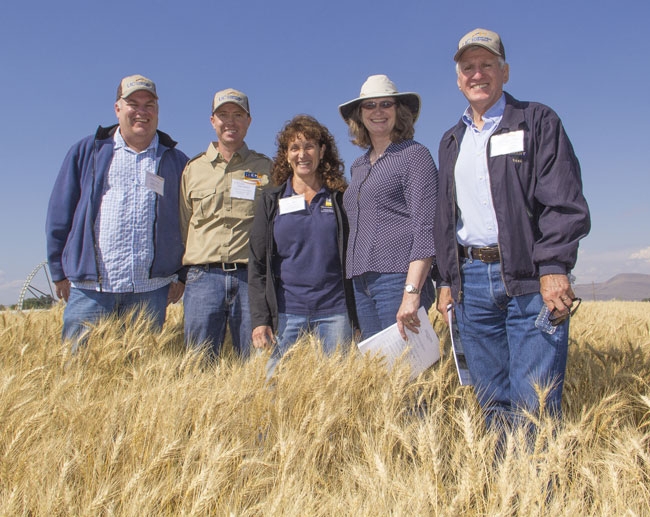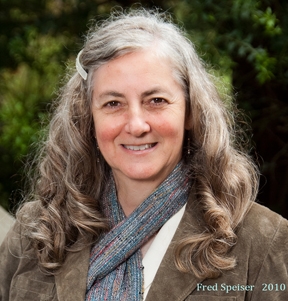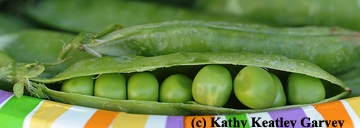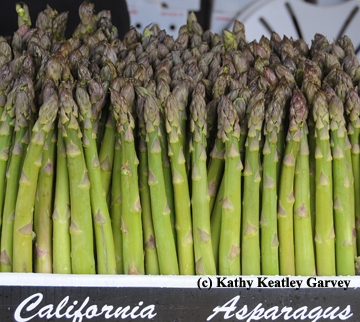Posts Tagged: green
San Joaquin County gardeners boost business with UC Cooperative Extension Green Gardener qualification
For a healthier family and environment, San Joaquin County homeowners can select a UC-qualified Green Gardener to take care of their lawns and landscapes.
Green Gardeners are landscape professionals who are trained and tested on up-to-date, environmentally friendly, science-based landscape practices.
“We're improving the knowledge and skill sets of workers who manage an enormous amount of urban acreage,” said Karrie Reid, the UC Cooperative Extension horticulture advisor in San Joaquin County. “We're helping them understand that they have the power to effect change in water conservation, quality of storm water runoff, and the amount of pesticides that are in the environment.”
To become qualified as a Green Gardener, participants attend classes eight weeknight evenings and two Saturday mornings. The first module addresses the importance of healthy soil for healthy landscapes. UC Cooperative Extension scientists provide training on soil building, pest control and green waste management. The second module focuses on mastering efficient irrigation and conducting an irrigation audit. The final sessions focus on plants in the California landscape, including turfgrass, trees and shrubs.
Because the Green Gardener program is partially funded by a dumping fee paid by residents to the county landfill, green waste management is a key component of the program.
“We have to reduce our green waste,” Reid said. “Our urban soils are in need of organic matter. By building soil with green waste, we are solving two problems that inhibit our urban landscapes' sustainability.”
Beginning with Module 1, the Green Gardener qualification program is being held for the fifth time Jan. 16 to March 12, 2018. The registration deadline is Jan. 12.
On the first day of an earlier session, a landscaper wondered aloud if the $90 fee and, particularly, the time commitment, would be worth it. “Well, I know the answer is that it was worth it,” he said.
In addition to all the knowledge gained, after passing the class, the participants can place the Green Gardener logo on their advertisements and be added to the online list of qualified UCCE Green Gardeners.
One Green Gardener, Jacob Wilson, wrote to Reid about a visit to a customer's property after a four-week break and found the lawn was significantly greener.
“I asked the customer if she had her sprinklers repaired,” Wilson said. “She said, ‘No, my sister adjusted the water schedule to two or three times during the night with shorter watering duration each time instead of watering once; like you said.'”
As his customer made her way back to the house, Wilson said he was feeling more like a professional.
Home gardeners aren't the only ones who can take advantage of the program. Reid has reached out to landscape professionals working in the county parks department and school districts. There are landscapers who tend apartment complex landscapes, commercial building landscapes, street medians and highway rights-of-way.
“I successfully pitched the program to the Sherriff's Department for their grounds landscape personnel,” Reid said.
For more information, visit the Green Gardener of San Joaquin County website at http://ucanr.edu/sites/GreenGardener.
UC research center in Tulelake commemorates UCCE centennial
The annual field day at the UC Intermountain Research and Extension Center held last week provided an opportunity to mark the 100th anniversary of UC Cooperative Extension with leaders of the organization, reported Todd Fitchette in Western Farm Press.
The research activities at the Intermountain center, situated near the California-Oregon border in Tulelake, focus on peppermint, horseradish, small grains, wheat, potatoes, alfalfa and onions. At the field day, UCCE researchers discussed the progress of alfalfa production in the Klamath Basin, suppressing white rot disease in processing onions, maximizing profitability of wheat, pest management in peppermint and other topics.
The Intermountain Research and Extension Center is one of nine centers under the UC Division of Agriculture and Natural Resources (ANR). The 140-acre facility provides UCCE advisors and specialists the space and support needed to conduct agricultural research in a high mountain interior valley climate zone.
The joy of eating green: Ten things you should know about saving money and eating healthier
You skipped breakfast and you're walking into the supermarket without a shopping list. Distracted by several two-legged and four-legged members of your household trying to compete for your attention, you left the list clipped to your refrigerator door.
You're famished. The potato chips look good. The glazed doughnuts look even better. And that chocolate candy bar? To die for.
Bring ‘em on!
No, wait a minute. Let's get real, let's get green and let's get healthy. And let's save some money.
Nutritionist Amy Block Joy, Cooperative Extension specialist emeritus, teaches a University of California, Davis, freshman class on “Eating Green” and we asked her for the 10 best ways to save money and eat healthier.
Joy, who holds a doctorate in nutritional sciences from UC Berkeley, specializes in nutrition and health disparities of diverse populations and nutritional ecology, as well as workplace ethics.
Her advice needs to be posted on every refrigerator in the country. (Along with that shopping list!)
- Shop with a list: Using a list will keep you focused on meal planning and reduce the temptation to buy unneeded items.
- Don't shop when you're hungry: Temptation is high when you're hungry. Eat first and you'll be less inclined to spend extra dollars on those food items placed near the check-out stand that are high in calories and fat and low in nutrition. That would be snacks! Try shopping after a meal and you will find yourself less tempted by those chocolate-covered pretzels!
-
Read the nutrition facts label: When shopping for the healthiest foods, you should read the nutrition fact labels to check out fat, calories, fiber, carbohydrates and sodium. Aim for low-fat, high-fiber foods that have essential vitamins and minerals. For example, if you want the best source of fiber - buy fresh oranges and eat them raw rather than selecting orange juice. However, if you want juice, be sure that you are getting real juice. And, some juices are now fortified with calcium - a big plus for increasing your calcium intake if you are not drinking milk.
- Read the ingredient lists: The ingredient list will provide important clues on products that you'll want to include in your diet. One of them is to look for whole grains. The information on the product may make you think the product is "natural" but what does that really mean? Not much because the phrase you want to look for is the "USDA organic" label. With so many choices of breads these days, you'll want to find ones that have whole grains and fiber. Find the information by reading the label (compare fiber amounts) and ingredients (look for "whole" grains).
-
Compare prices: Supermarkets provide price-comparison information located by their products. You can compare the "unit" costs so that you'll be able to determine the lowest cost of the product. Two words of caution: products "on sale" may not be the best bargains.
- Shop the perimeter of the store: Marketing experts have placed the healthiest foods at the farthest corners of the store so that the shopper has to stroll through the other items before finding fruits and vegetables, protein sources (poultry, meats), dairy products and cereal products.
- Think protein: Buy meat and poultry on sale and use these foods to make stews, soups and chili. This way you can stretch these more expensive food sources. Beans are a great source of protein and are low fat and high in fiber.
- Plan meals ahead: The best way to save money is to plan your meals in advance. Buying unprocessed foods will improve your health and also save money. It costs to add preservatives, food additives and packaging of products that you, the consumer, are paying for. It's much cheaper to buy rice in bulk rather than already prepared rice products. Brown rice contains more fiber than white rice.
- Cook! Your grandmother was right. Food prepared from scratch will taste better, be healthier and save money. Research has shown that cooking not only saves money but improves nutrition.
- Enjoy! Food is meant to be a pleasant happy experience. Don't forget to enjoy it!
So, the next time you're racing out the door on your way to the supermarket, be sure to eat first so you're not tempted by foods that you know aren't good for you.
And that shopping list? You can also key that in on your cell phone so neither the list, nor your phone, will get left behind.
Meanwhile, we all ought to follow Amy Block Joy's great advice on saving money, eating green, and being healthier.
As I wrote on one of my college essays, "We have a choice in the matter and it matters that we have a choice."
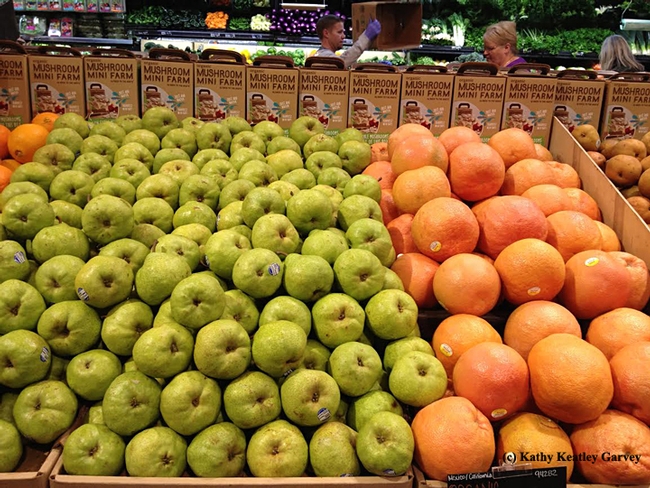
The produce aisle is a good place to "go green and eat healthier." (Photo by Kathy Keatley Garvey)
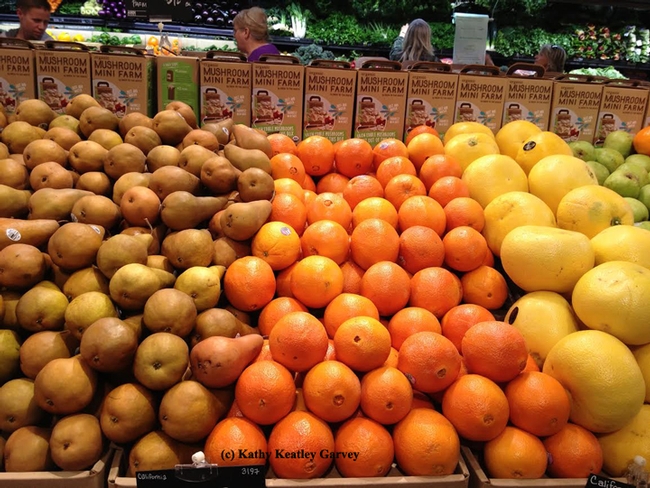
Grocery stores usually place fruits and vegetables around the perimeter. (Photo by Kathy Keatley Garvey)
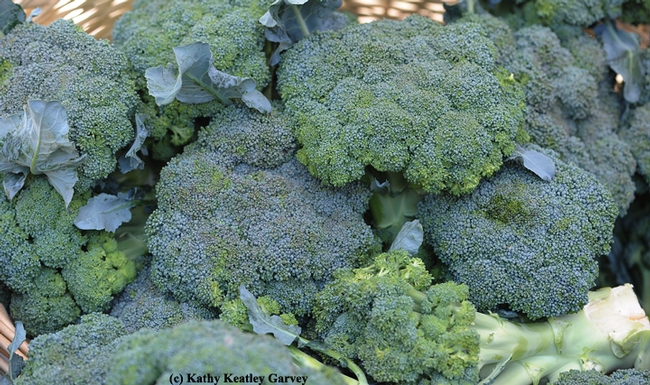
Broccoli--a food everyone should love. (Photo by Kathy Keatley Garvey)
Just bee-cause
It's National Pollinator Week. Have you hugged your pollinators today, particularly the bees?
If you don't pay attention to the bees around you, you may think that every floral visitor is a honey bee (Apis mellifera) or a bumble bee (Bombus).
Not!
If you look closely, you'll see bee diversity: leafcutter bees, green metallic sweat bees, cuckoo bees, long-horned bees, carpenter bees, and squash bees, just to name a few.
Native pollinator specialist Robbin Thorp, UC Davis emeritus professor of entomology, has detected 80 different species of bees - and counting - in the Häagen-Dazs Honey Bee Haven on Bee Biology Road at UC Davis. The half-acre garden, planted in the fall of 2009, is located next to the Harry H. Laidlaw Jr. Honey Bee Research Facility. It's intended to be a year-around food source for the Laidlaw bees and other pollinators, to raise public awareness about the plight of bees, and to demonstrate what you can plant in your own garden.
"Of about 4,000 bee species known in the entire United States, about 1,600 have been recorded in California," according to Gordon Frankie of UC Berkeley, Robbin Thorp and their colleagues, in a must-read article in California Agriculture.
They point out: "...many types of urban residential gardens provide floral and nesting resources for the reproduction and survival of bees, especially a diversity of native bees. Habitat gardening for bees, using targeted ornamental plants, can predictably increase bee diversity and abundance, and provide clear pollination benefits."
Be sure to check out UC Berkeley's Urban Bee Gardens website that's described as "a practical guide to introducing the world’s most prolific pollinators into your garden." It's an educational treasure.
Bottom line: It's good to bee-aware, especially when research studies show that our pollinator population is declining worldwide.
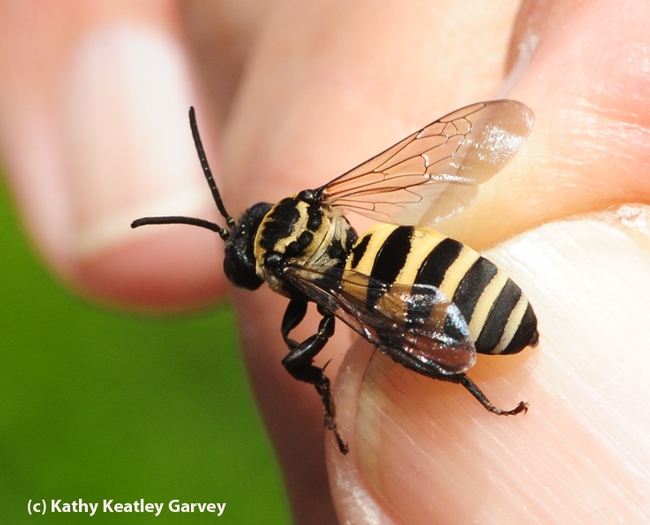
A male cuckoo bee, Triepeolus concavus, the cuckoo that is a cleptoparasite on Svastra, according to Robbin Thorp. (Photo by Kathy Keatley Garvey)
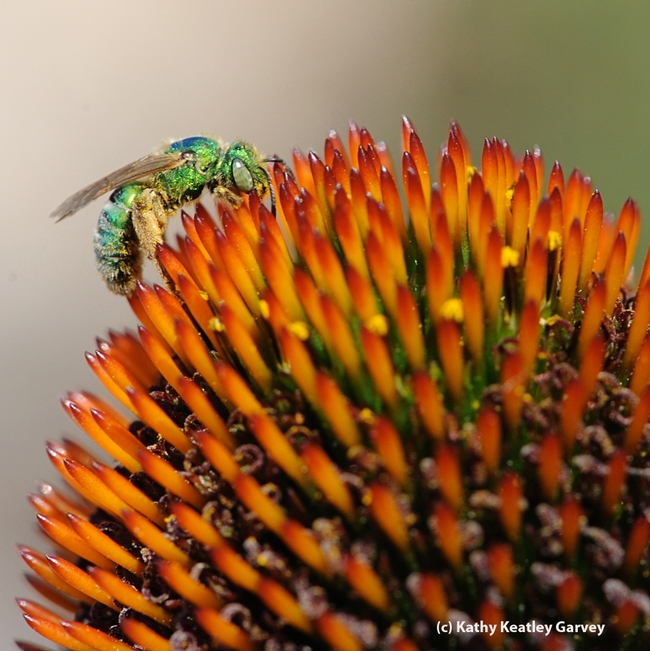
Female metallic green sweat bee, Agapostemon texanus. (Photo by Kathy Keatley Garvey)
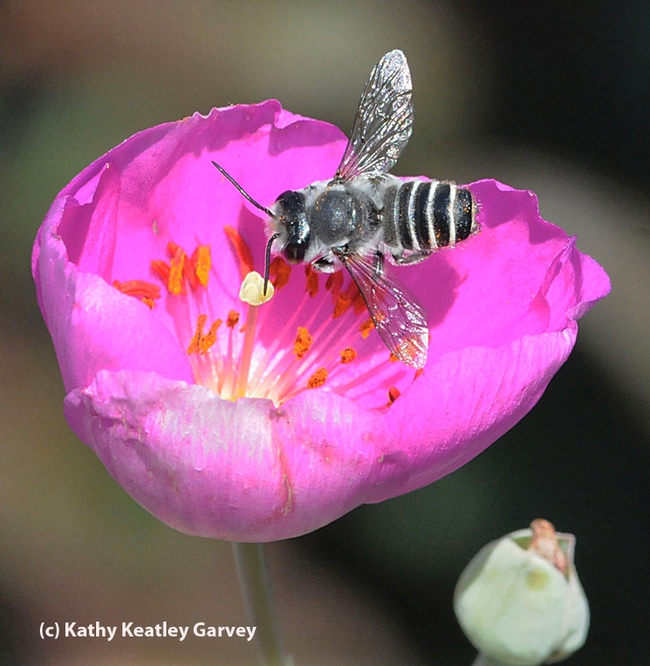
A male leafcutting bee, Megachile sp., on rock purslane. (Photo by Kathy Keatley Garvey)
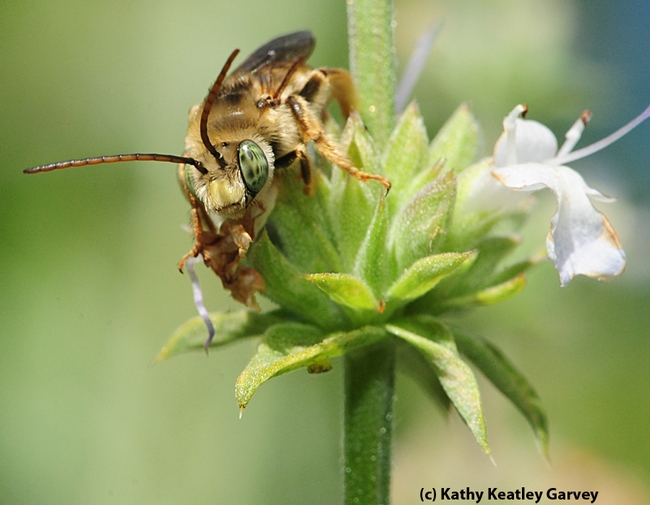
A male long-horned bee, Melissodes communis, on salvia. (Photo by Kathy Keatley Garvey)
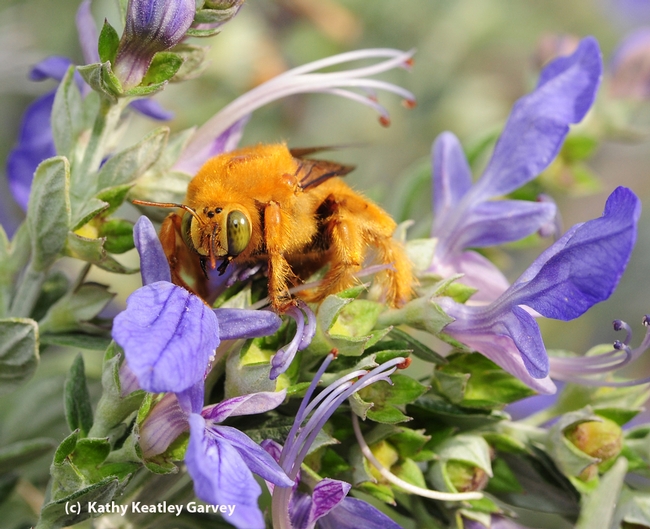
A male Valley carpenter bee, Xylocopa varipuncta. (Photo by Kathy Keatley Garvey)
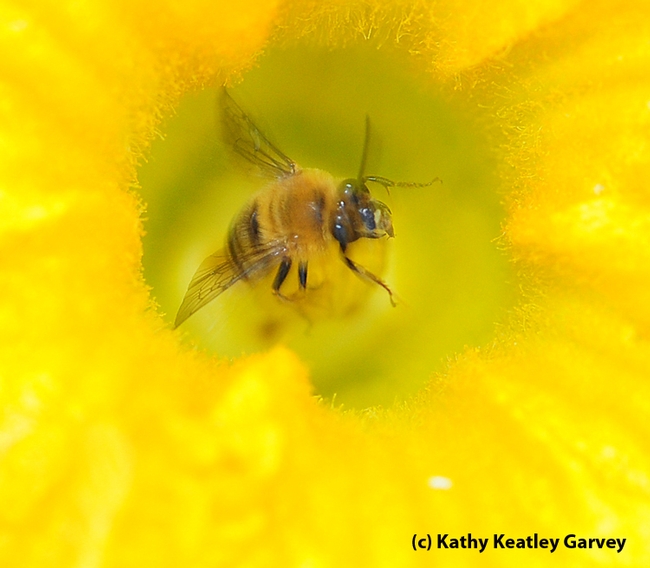
Male squash bee, Peponapis pruinosa. (Photo by Kathy Keatley Garvey)
Survey identifies 19 produce candidates for a farm-to-WIC program
A new federal voucher that gives low-income women access to a range of fruits and vegetables could provide unique new marketing opportunities for California growers.
In 2009, the federal Special Supplemental Nutrition Program for Women, Infants and Children (WIC) began distributing monthly cash vouchers to low-income women with children to buy fruits and vegetables. The program reaches almost half of the infants and one-quarter of children under 5 years old in the United States.
A team of UC Cooperative Extension (UCCE) researchers and nutrition advisors has been exploring the possibility of developing a farm-to-WIC program that would link these low-income consumers with local growers. The purpose of such a program would be to increase the consumption of a wide variety of fresh produce, with a focus on locally grown produce when available.
UCCE conducted a survey of produce preferences and buying habits among WIC participants in Tulare, Alameda and Riverside counties in 2010. The full study is published in the January-March 2012 issue of California Agriculture journal.
Based on the results, the UCCE team developed a list of 19 produce items to promote in a possible new farm-to-WIC program. They are:
|
|
|
Although mustard greens and collards were not popular across all sites, the advisors gauged a potential market in Alameda County, so these were retained. Based on write-in responses, oranges were also added.
In California, which has the nation's largest WIC program, 82 local agencies serve about 1.43 million participants at 623 local centers, and WIC participants can redeem their monthly vouchers at 4,000 grocery stores statewide. About 40 percent shop at WIC-only stores, which stock and sell only WIC-authorized foods.
Stocking produce is relatively new to WIC-only stores; before rollout of new WIC food packages in October 2009, these stores were only required to stock limited amounts of fresh carrots. In the survey, most WIC participants (58 percent to 72.3 percent) responded that their preferred stores offered many choices, but fewer participants (18.5 percent to 41 percent) rated the produce quality as “excellent.” Key factors determining purchase decisions were produce quality and freshness, and nutrient value (vitamins and minerals). Cost was relatively less important, possibly because WIC participants procure the produce with the vouchers.
The list has served as a starting point for discussions with growers and WIC vendors.
“The survey showed that WIC participants were interested in purchasing fresh produce with better quality and more variety,” wrote lead author Lucia L. Kaiser, Cooperative Extension specialist in the UC Davis Department of Nutrition, and co-authors, in California Agriculture. “Some WIC participants that we surveyed said they avoided shopping at WIC-only stores in part because these interests were not met.”
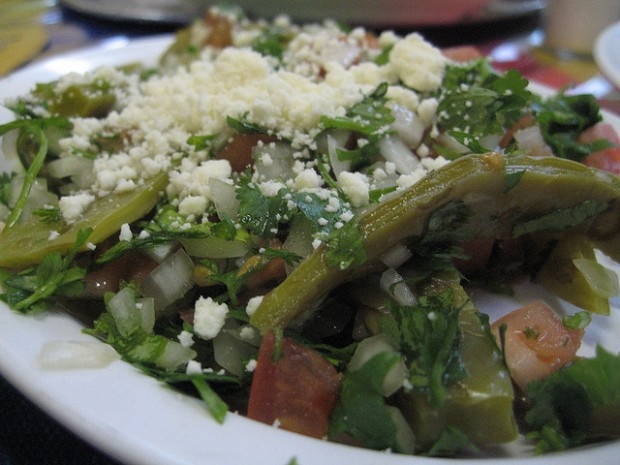
A dish made with nopales (cactus pads).

